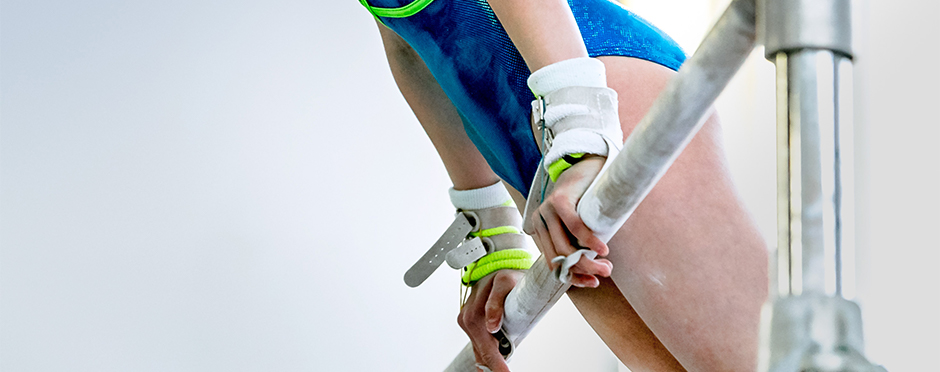
Wrist Pain in Tumbling Athletes
Leave a CommentTumbling athletes, including gymnasts and cheerleaders, place unique demands on their upper body. When tumbling, the athlete places not only their entire body weight through the hands but can have up to 16 times their body weight in force going across the wrist.1 Due to these extreme conditions, pain in the wrist can occur.
Cause of Pain Considerations
Even though the wrist joint might be where the athlete is experiencing pain, we must consider the other joints of the arm and spine used during tumbling including the elbow, shoulder, shoulder blade, and the thoracic spine (upper to mid back). We should look at the joints, ligaments, and the muscles surrounding each of these joints. When a small part of this chain is not functioning properly, the small stabilizing muscles are not able to perform their job which can lead to unnecessary stress on other joints in the chain.
Tumbling athletes should examine their shoulder and upper back flexibility if they are having wrist pain. Tightness in the shoulders or the thoracic spine can limit the range of motion available for tumbling movements. To compensate and complete the tumbling move, the athlete may be over-stretching their wrist or other areas of the body. Overusing the wrist in this way repetitively can lead to injury.
Treatment Options
Treatment for wrist pain includes assessing all the joints of the upper body as stated above and addressing limitations found. Stretching for the shoulders and back as well as strengthening the entire chain and strengthening the wrists are all important. If wrist pain is severe, rest from tumbling would also be recommended to decrease further injury risk. To return to tumbling, weight bearing on hands should be pain-free in static positions such as in handstands or bridges.
Examples of Strengthening Exercises:
- Wrist curls both directions with a weight or resistance band
- Wrist rotation exercises such as rolling a hand weight
- Supination/Pronation (up and down movements) with a hand weight – make sure to perform at slow speed and with controlled motion
- Resistance band exercises including rows, shoulder extension, diagonals, internal/external rotation
- Tricep extension with band or hand weight
- Bicep curls with band or hand weight
- Gradual return to weight bearing exercises including push-ups, planks and handstands can be added when the athlete is pain-free in the wrist. Athletes can begin with weight bearing on a wall such as wall push-ups or a modified push-up on hands and knees if full weight bearing is still uncomfortable.
Stretches for Shoulders and Thoracic Spine:
- Lie on foam roller with it perpendicular to spine and roll up/down along upper back promoting extension in thoracic spine. Keep core stomach muscles tight and focus on upper back rather than low back.
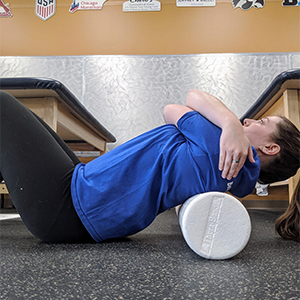
- Perform shoulder stretch with foam roller, focusing on stretching shoulders and upper back. Lie on your stomach with arms overhead. Place foam roller under your wrists. Try not to arch low back and focus on shoulders and upper back. If foam roller is too large to start, use 1 panel mat instead.
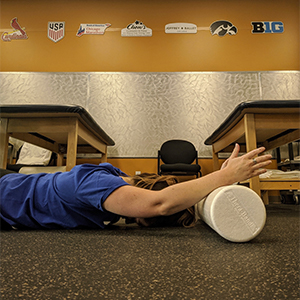
- Foam roll your lats. Lie on your side with that arm overhead with foam roller under your arm along ribcage area. Gently roll side of your body and adjust pressure by using other hand for support on ground.
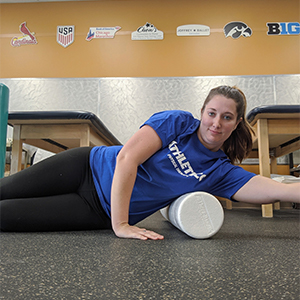
- Doorway stretch for your pec muscles. Stand in a doorway with arms on frame and step through the door until a stretch is felt on front of chest. Hold for 20 seconds.
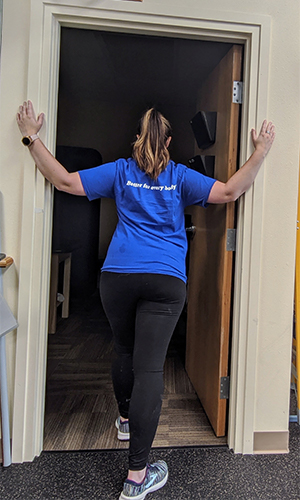
- Another pec stretch involves lying on a foam roller with roller parallel to your spine and allow your arms to relax out to the side. You can bring arms up higher or bend elbows as if in a goal post until stretch is felt across front of chest. Hold for 20 seconds.
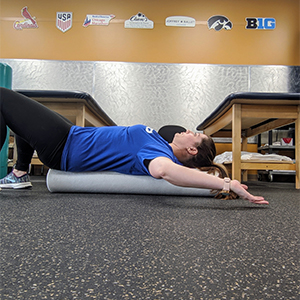
Wrist Guards
Seen often in gymnastics, wrist guard use can help protect the wrist against high weight-bearing forces. Wrist guards limit hyperextension during tumbling or weight-bearing skills. Wrist guards do not improve flexibility elsewhere however; athletes should assess their flexibility in their shoulders and back and address limitations in other regions to improve their tumbling form. Wrist guards do limit the strength development in the joints and muscles around the wrist therefore a wrist strength and conditioning program is highly recommended even when wearing wrist guards.
Athletico provides rehabilitation services to gymnasts and cheerleaders at all levels and abilities. Our goal is to evaluate, treat, and educate athletes in the prevention of practice and competition-related injuries. Technical evaluations can be performed to improve postural awareness and maximize the function of each athlete. We have physical therapists and athletic trainers, including former gymnasts and cheerleaders at the high school, collegiate, and Olympic levels, involved with our Gymnastics and Cheerleading Program. Our clinicians understand the demands of the sport and use their personal and professional experience to effectively address the physical and psychological needs of each athlete.
For more information contact a Gymnastics and Cheerleading Rehabilitation Clinician by emailing Gymcheer@athletico.com.
The Athletico blog is an educational resource written by Athletico employees. Athletico bloggers are licensed professionals who abide by the code of ethics outlined by their respective professional associations. The content published in blog posts represents the opinion of the individual author based on their expertise and experience. The content provided in this blog is for informational purposes only, does not constitute medical advice and should not be relied on for making personal health decisions.
References:
1. Webb BG, Rettig LA (2008) Gymnastic wrist injuries. Curr Sports Med Rep 7:289–295
